Table of Contents
Introduction
Smart Glasses Statistics: Smart glasses are wearable devices that combine eyeglasses or sunglasses with electronic features. Displaying digital information in the user’s field of vision through technologies like optical projection and OLED screens.
Often associated with augmented and mixed reality, they offer features such as cameras, voice control, connectivity, sensors, and audio output.
Smart glasses find applications in enterprise, healthcare, consumer, education, and gaming sectors. With ongoing challenges including privacy concerns and design aesthetics.
Future trends involve improved technology and AI integration, promising a more versatile and integrated role in our daily lives.
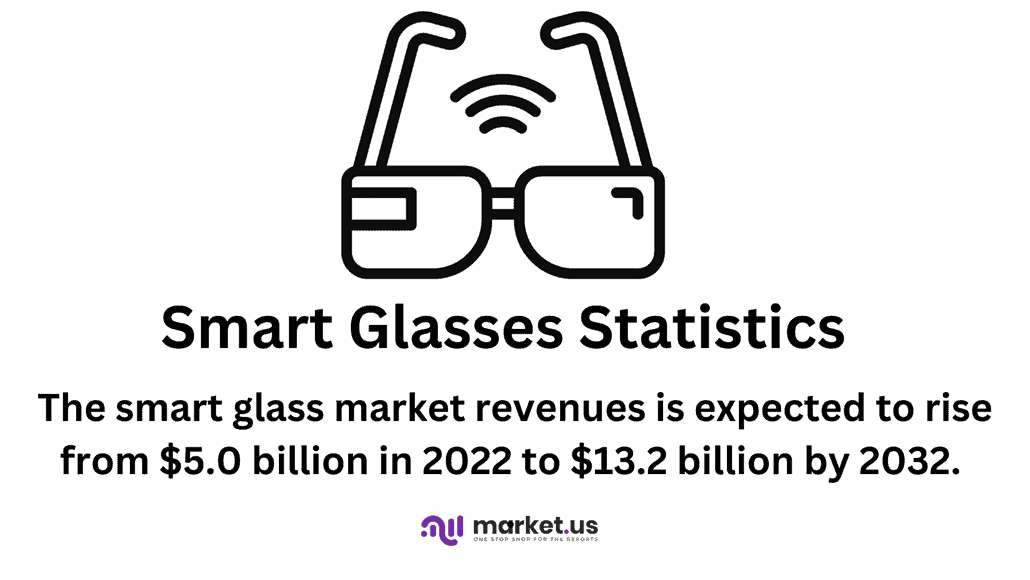
Editor’s Choice
- The revenue of the wearable technology market has shown a steady and consistent increase at a CAGR of 14.60% over the years. Starting at $61 billion in 2022 and steadily rising to $70 billion in 2023.
- The smart glass market is poised for steady growth over the next decade. With revenues expected to rise from $5.0 billion in 2022 to an estimated $13.2 billion by 2032.
- Electrochromic and polymer-dispersed liquid crystal (PDLC) technologies each accounted for $1 billion in revenue. While suspended particle devices (SPD) and thermochromic technologies contributed another billion dollars collectively.
- Regarding market share, transportation stands out as a dominant force, commanding 30% of the market.
- In 2017, the unit smart glass shipments were relatively modest at 0.23 million units. However, by 2022, unit shipments skyrocketed to an impressive 32.7 million units.
- The AR glasses market is projected to experience substantial growth. With estimated unit sales of 2.11 million units in 2023 and a remarkable 3.9 million units in 2024.
- 49% of surgeons believe smart glasses can potentially decrease complications and fatalities in operating rooms, primarily resulting from human error.
Market Overview
Wearable Technology Market
- The revenue of the wearable technology market has shown a steady and consistent increase at a CAGR of 14.60% over the years. Starting at $61 billion in 2022 and steadily rising to $70 billion in 2023.
- This growth trajectory is anticipated to continue, with projections indicating revenues of $79 billion in 2024, $94 billion in 2025, and $109 billion in 2026.
- As we move into the late 2020s, the market is expected to reach $123 billion in 2027, $134 billion in 2028, and $154 billion in 2029.
- The trend of expansion persists, with estimates of $173 billion in 2030, $199 billion in 2031, and an impressive $231 billion in 2032.
- This consistent growth can be attributed to the increasing consumer demand for wearable devices. Including smartwatches, fitness trackers, and augmented reality gadgets. All offer a wide range of features, from health monitoring to communication, driving their popularity and market revenue.
- This data underscores the significance of wearable technology in today’s digital landscape and its potential to reshape various industries in the years to come.
(Source: Market.us)
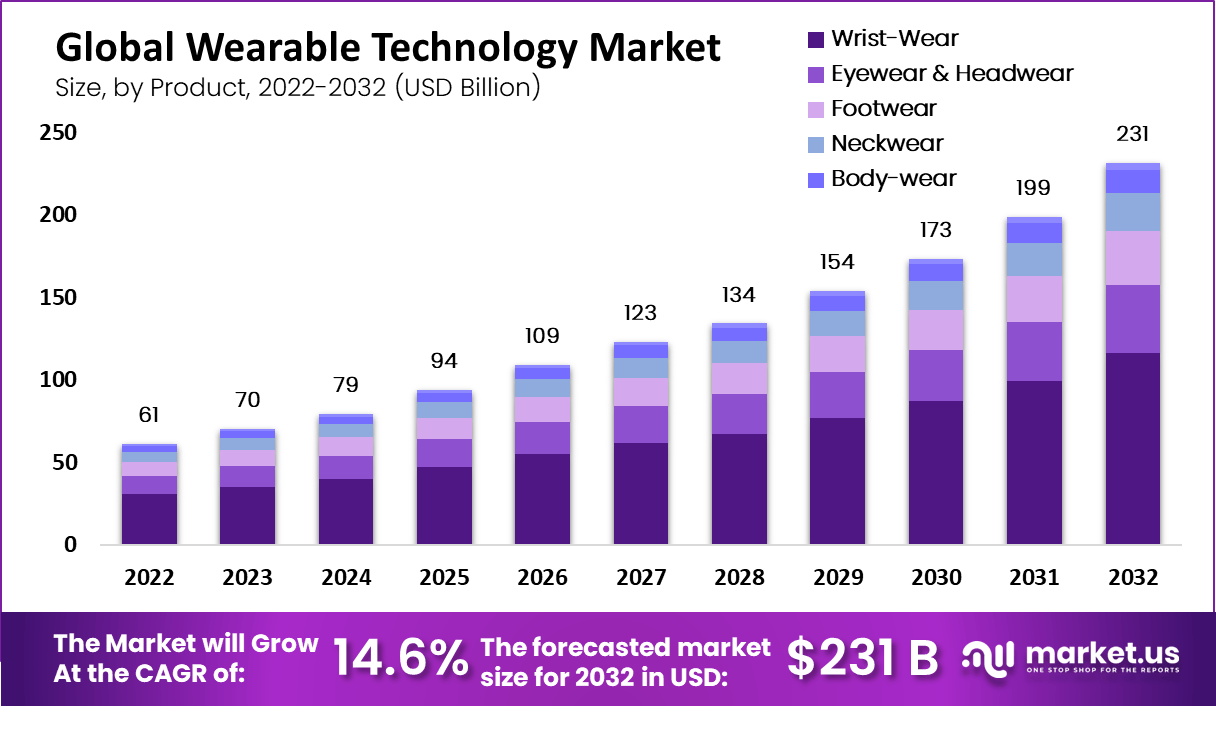
Smart Glasses Market Size and Growth Statistics
- The smart glass market is poised for steady growth over the next decade. With revenues expected to rise from $5.0 billion in 2022 to an estimated $13.2 billion by 2032.
- This impressive growth trajectory reflects the increasing adoption of smart glass technologies across various industries.
- In 2023, the market is projected to reach $5.5 billion, marking a 10% increase from the previous year.
- The growth trend continues, with revenues reaching $6.0 billion in 2024 and steadily climbing to $11.8 billion in 2031.
- By 2032, the smart glass market is anticipated to reach $231 billion. Underlining the growing demand for innovative solutions that offer transparency control and energy efficiency.
- This sustained growth is driven by factors such as the integration of smart glass in architecture, automotive, and consumer electronics. As well as the emphasis on sustainability and energy conservation in the built environment.
- As smart glass technologies evolve and become more affordable. Their market presence is set to expand, offering a brighter future for this dynamic industry.
(Source: Market.us)
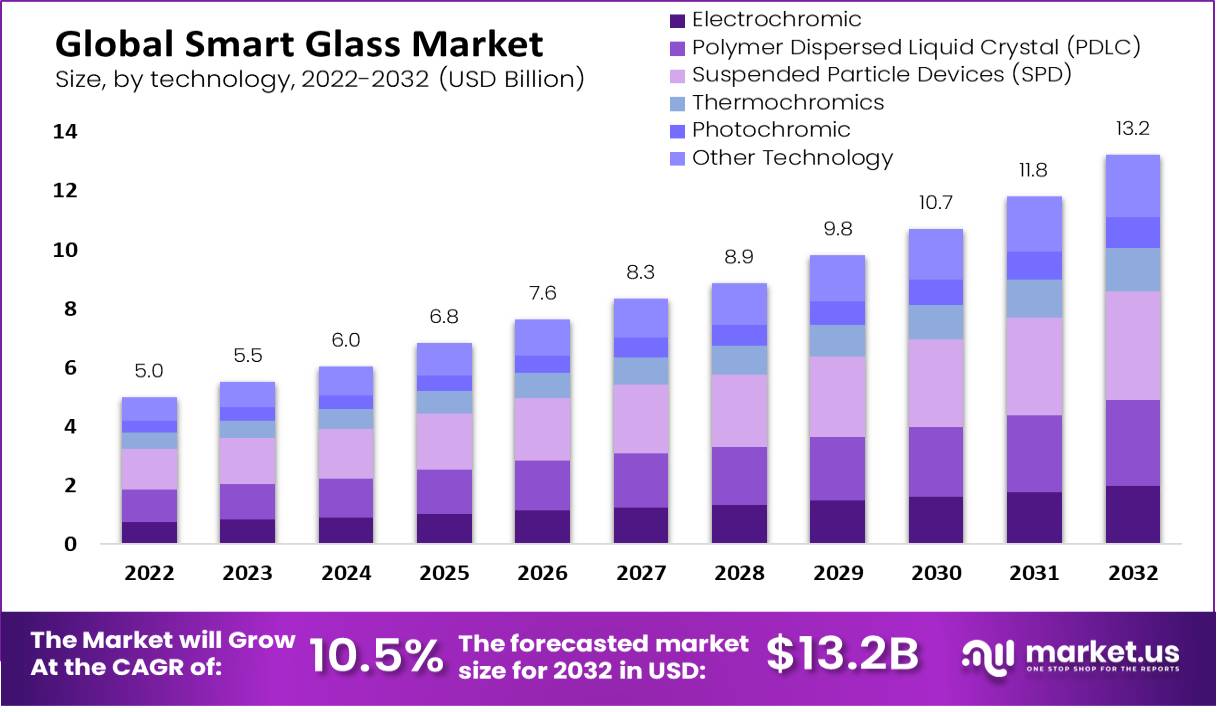
Global Smart Glass Market Revenue – By Technology Statistics
- The global smart glass market is experiencing a dynamic evolution in technology-driven revenue growth. In 2022, the market generated a total revenue of $5.0 billion, with various technologies contributing to this figure.
- Electrochromic and polymer-dispersed liquid crystal (PDLC) technologies each accounted for $1 billion in revenue. While suspended particle devices (SPD) and thermochromic technologies contributed another billion dollars collectively.
- Photochromic technology added a modest $0.1 billion, and there was an additional billion from other technologies.
- The smart glass market is poised for substantial expansion as we look ahead. By 2032, the total market revenue is forecasted to reach an impressive $13.2 billion. Advancements across the spectrum of smart glass technologies fuel the growth.
- Electrochromic and PDLC technologies maintain their presence, generating $3 billion in revenue by 2032. However, SPD technology stands out with $4 billion in revenue, showcasing its growing importance in the market.
- Thermochromic technology also experiences steady growth, reaching $1 billion in revenue. Photochromic technology and other emerging technologies contribute to the market with $1 billion and $2 billion in revenue, respectively.
- This data highlights the ever-expanding role of smart glass technologies in various sectors. From architecture and automotive to consumer electronics and beyond.
- The market’s robust growth reflects the increasing demand for energy-efficient and transparent solutions. Underlining the vital role that smart glass plays in shaping the future of multiple industries.
(Source: Market.us)
Take advantage of our unbeatable offer - buy now!


Smart Glass Market Share- By Application Statistics
- The smart glass market exhibits a diverse distribution of market share across various applications, with each sector playing a unique role in driving its growth.
- Regarding market share, transportation stands out as a dominant force, commanding 30% of the market.
- This underscores the increasing integration of smart glass in automotive and aerospace applications. Which is used to enhance passenger comfort and improve energy efficiency.
- Architectural applications closely follow, with a substantial 26% market share. The adoption of smart glass in buildings and infrastructure is on the rise. Driven by the desire for energy-efficient solutions and innovative designs that offer dynamic transparency control.
- Consumer electronics comprise a significant portion of the market, holding 21% of the share.
- This reflects the growing demand for smart glass in electronic devices. Such as smartphones, tablets, and wearables, which are used for displays and augmented reality applications.
- Power generation applications contribute 13% to the market share. Indicating the use of smart glass in solar panels and energy-efficient windows.
- Finally, other applications comprise 10% of the market share, encompassing a range of niche sectors where smart glass technology finds unique applications.
- This distribution of market share underscores smart glass’s versatility and expanding reach across different industries. As it continues to evolve and innovate to meet the diverse needs of these various sectors.
(Source: Market.us)
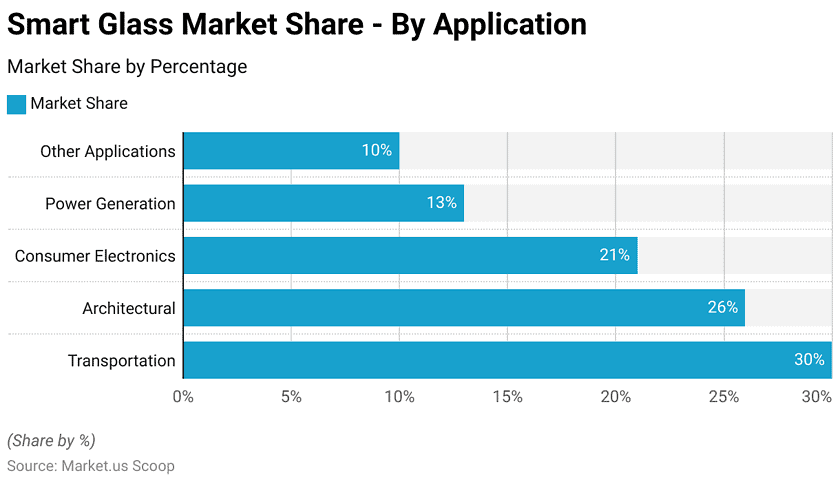
Smart Glasses Shipments Worldwide Statistics
- The smart glasses market has seen a significant transformation in unit shipments over the years, marking a notable shift in consumer adoption.
- In 2017, the unit shipments were relatively modest at 0.23 million units, indicating limited consumer interest and market penetration.
- However, fast-forward to 2022, and the landscape has dramatically changed.
- Unit shipments skyrocketed to an impressive 32.7 million units, showcasing a substantial surge in demand and adoption of smart glasses.
- This substantial increase can be attributed to technological advancements, expanded use cases across various industries, and a growing consumer appetite for wearable augmented reality devices.
- The rapid growth in unit shipments over this period underscores smart glasses’ increasing relevance and market presence, hinting at a promising future for this evolving technology.
(Source: Statista)
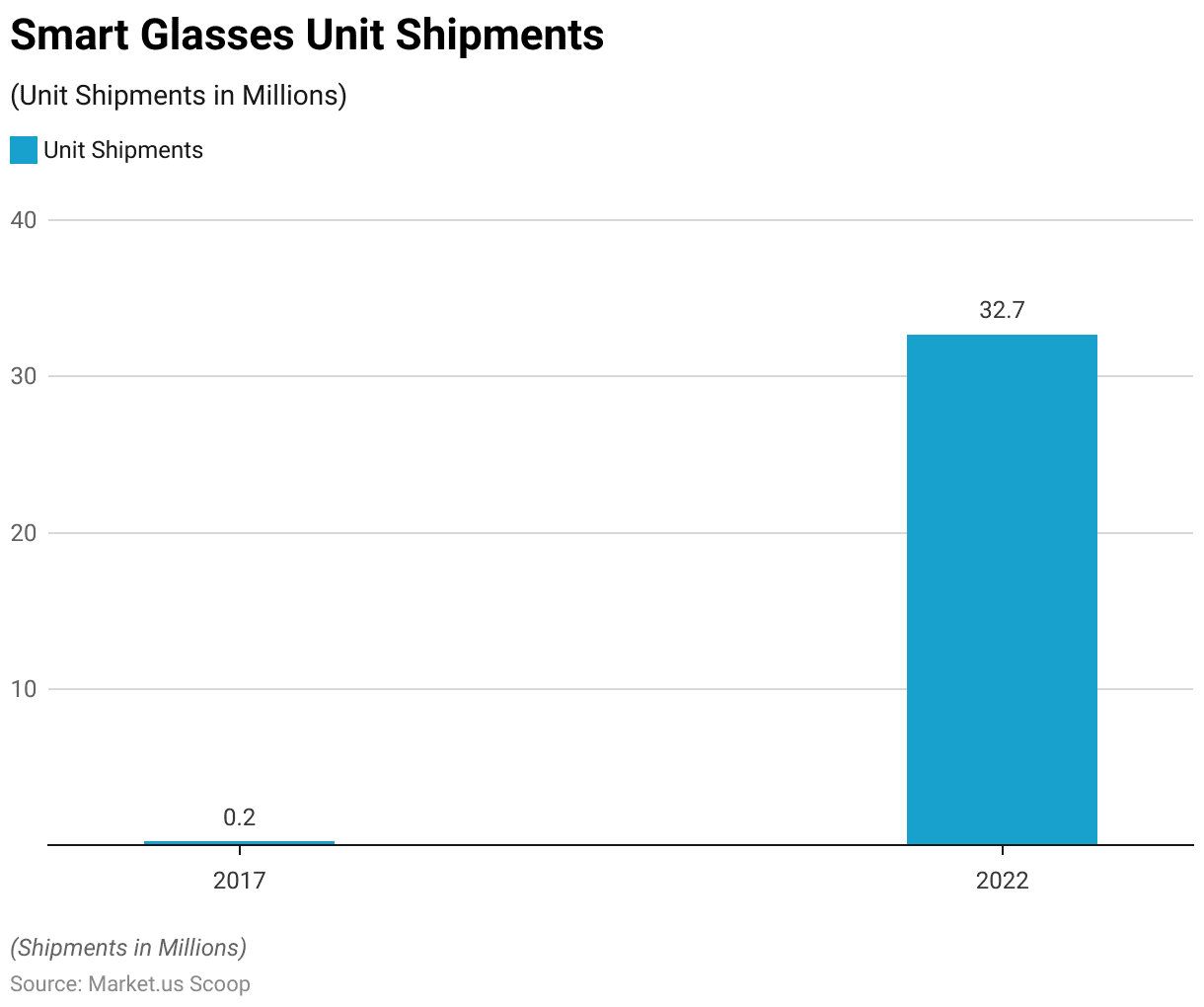
Smart Augmented Reality Glasses Statistics
Global Smart Augmented Reality Glasses Market Size
- The smart augmented reality glasses market has exhibited a remarkable growth trajectory over the past few years.
- Starting at 138.61 million dollars in 2016, the market experienced substantial expansion, with revenues surging to 19,718.88 million in 2022.
- This exponential growth can be attributed to several factors, including technological advancements, increased adoption in various industries such as healthcare and enterprise, and a growing demand for immersive augmented reality experiences.
- The market witnessed significant milestones, with revenues surpassing 4.4 billion in 2018 and 15.7 billion in 2021.
- This robust growth trend underscores smart augmented reality glasses’ growing prominence and potential, poised to continue shaping the future of augmented reality applications and wearable technology.
(Source: Statista)
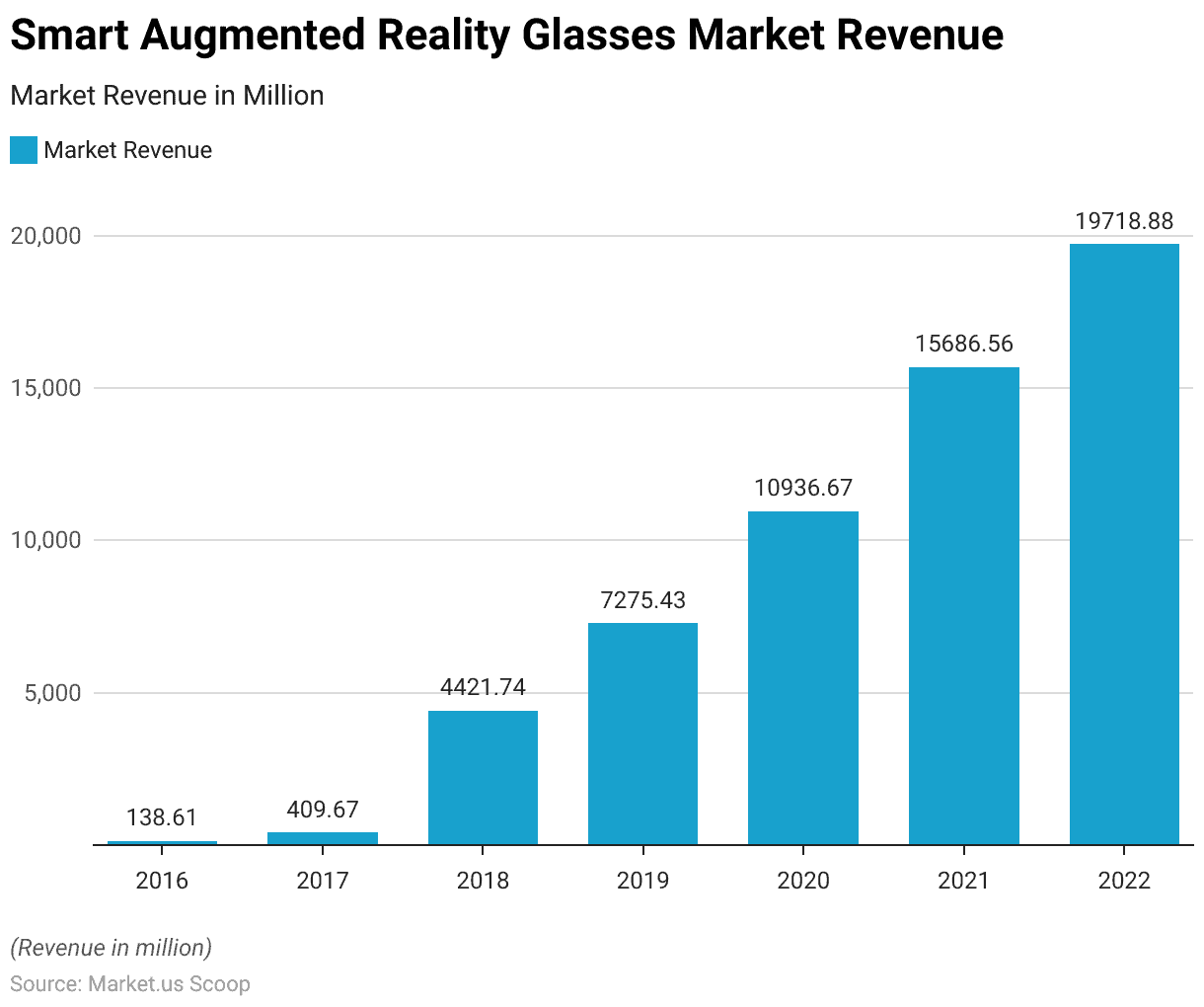
Augmented Reality (AR) Glasses Sales
- The augmented reality (AR) glasses sales have significantly increased over the years, reflecting a growing interest and adoption of this technology.
- In 2019, unit sales stood at a modest 0.17 million units, demonstrating a relatively slow start. However, by 2020, sales began to pick up, reaching 0.25 million units.
- The momentum continued to build in 2021, with sales climbing to 0.41 million units. The real surge came in 2022 when sales nearly doubled to 0.96 million units.
- Looking ahead, the AR glasses market is projected to experience substantial growth, with estimated unit sales of 2.11 million units in 2023 and a remarkable 3.9 million units in 2024.
- This upward trajectory underscores AR glasses’ increasing popularity and potential applications, indicating a promising future for this technology in various industries and consumer markets.
(Source: Statista)
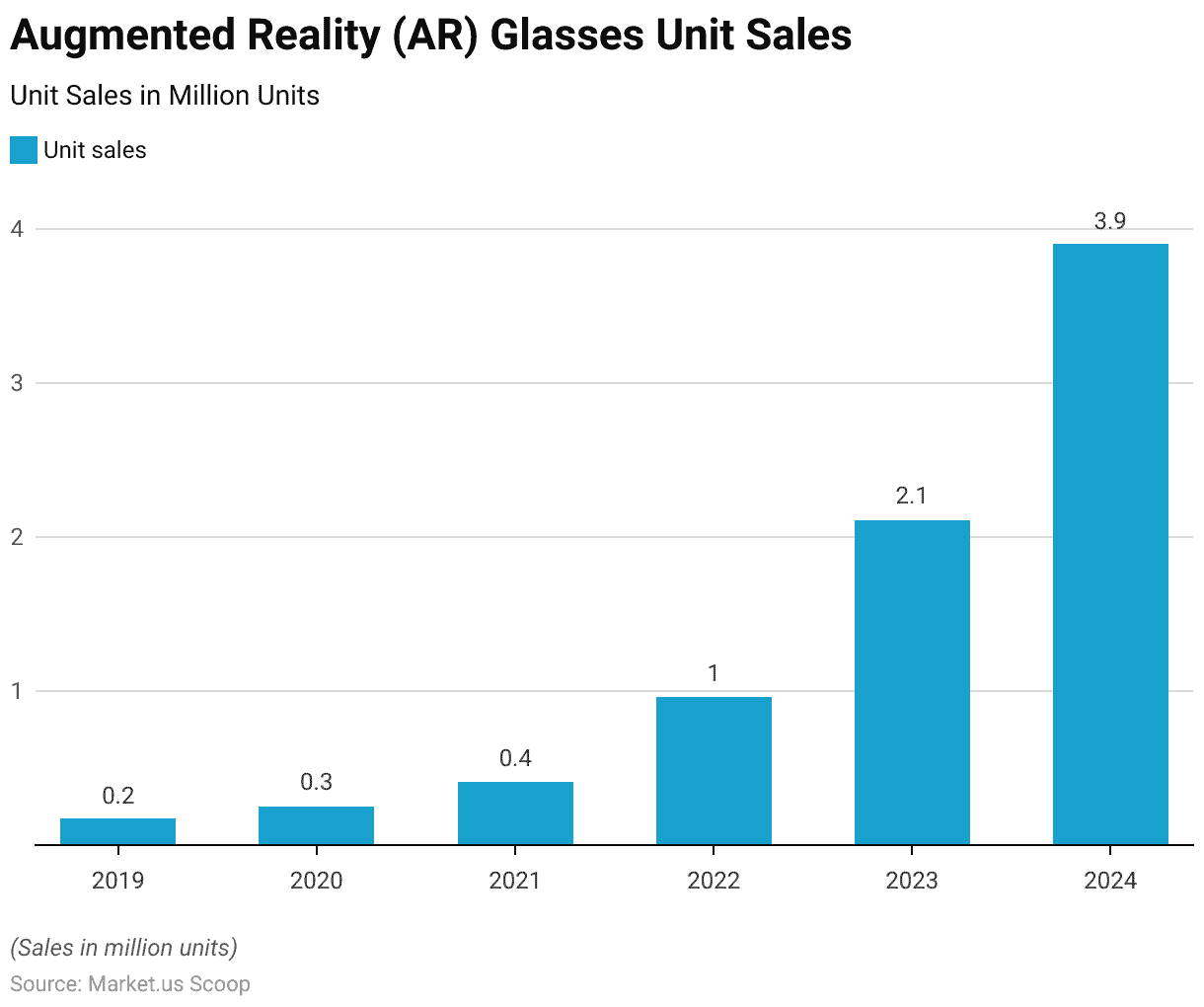
Benefits of AR Smart Glasses
- Around half of the surgeons have undergone training with AR smart glasses and acknowledge their superiority compared to traditional methods.
- Additionally, approximately 49% believe these glasses can potentially decrease complications and fatalities in operating rooms, primarily resulting from human error.
- Moreover, a significant group, comprising about 44%, has emphasized the remarkable capability of AR smart glasses to furnish essential information directly within their line of sight.
- This information includes intricate 3D anatomical images, real-time medical references, and patient data, enhancing surgical procedures.
- Furthermore, roughly 41% have recognized the potential of these smart glasses in enhancing safety within surgical environments by reducing the need for unnecessary entries and exits from the operating room.
- Moreover, roughly one-third of the respondents, approximately 30%, foresee the possibility of cost savings associated with surgical equipment and workforce management.
- Additionally, 28% have acknowledged the advantages of collaborating with remote clinical teams and gaining access to surgical expertise on a global scale, showcasing the global potential of AR smart glasses.
- Lastly, 26% have expressed the belief that AR smart glasses have the potential to significantly expedite surgical preparation times, making them a valuable tool in the medical field.
(Source: Vuzix Corporation)
Popular Smart Glasses Statistics
Nreal Air AR Smart Glasses Statistics
- The Nreal Air AR Glasses come with some impressive specs. They’re incredibly lightweight, tipping the scales at just 2.79 ounces, and have 5.83 x 2.36 x 2.05 inches dimensions, making them comfortably portable.
- It’s worth noting that the battery life depends on the Nreal adapter or the phone the glasses are connected to.
- These glasses are designed to work seamlessly with devices on their compatibility list, offering versatility in usage.
- These glasses are available at a reasonable price of $379.
- But what sets these AR glasses apart is their expansive field of vision, stretching out to a whopping 201 inches.
- There are three levels to explore: Air casting, virtual desktop, and AR space. The beauty is that you can choose the level that suits your needs based on the device you connect to the glasses.
- Air casting, for example, takes your phone, PC, or gaming system and transforms it into a larger-than-life screen, offering a generous 130-inch spatial display.
(Source: ZDNet)
Razer Anzu Smart Glasses Statistics
- The Razer Anzu Smart Glasses offer a sleek and lightweight design, coming in at just 1.6 ounces with dimensions of 6.42 x 1.87 x 6.07 inches, ensuring comfort during extended wear.
- These smart glasses are priced at $200 but are currently available for a discounted price of $88 on Amazon, making them an affordable option.
- One standout feature of the Razer Anzu smart glasses is their eye-care functionality. They are equipped with blue light filtering and polarized sunglasses lenses, which help reduce eyestrain.
- Their impressive performance sets these smart glasses apart in the audio department. They feature a 60ms Bluetooth connection that ensures seamless audio playback without delays or interruptions.
- This makes them ideal for listening to music, taking calls, or engaging in other audio-related activities while on the go.
- Furthermore, the Razer Anzu glasses offer a respectable battery life of more than 5 hours on a single charge, ensuring that they can keep up with your daily activities without needing frequent recharging.
(Source: ZDNet)
Rokid Air AR Smart Glasses Statistics
- The Rokid Air AR Glasses come packed with impressive features. They’re designed to focus on convenience and portability, weighing 2.93 ounces and measuring 7.14 x 6.15 x 2.16 inches.
- Despite their compact size, they offer a compelling cinematic experience. Once you put them on, you’re immediately transported into a 120-inch cinematic world, no matter where you are.
- This immersive experience is made possible by their HD 1080p OLED display and an expansive 43-inch field of view.
- The Rokid Air AR glasses provide access to 3D AR video content through the Rokid Air app, broadening your entertainment horizons.
- Additionally, these glasses are designed to accommodate users with myopia. They feature adjustable knobs that allow for myopia correction ranging from 0.00 to -5.00D for each eye, ensuring a comfortable viewing experience for nearsighted individuals.
(Source: ZDNet)
Patriot ViewPoint Low Vision Smart Glasses Statistics
- The Patriot ViewPoint Low Vision Glasses are a remarkable technology with specific specifications.
- They weigh in at 1.2 pounds and have dimensions of 7.95 x 4.58 x 3.65 inches, which positions them as a substantial yet functional wearable device.
- These glasses are priced at $2,995, and while they are not compatible with prescription lenses, they offer a unique set of features.
- What sets these glasses apart is their utilization of Samsung virtual reality technology, providing users with a captivating 101-degree widescreen experience. This widescreen view enhances the visual experience and offers a broader field of vision.
- One standout feature is the glasses’ voice command functionality. Users can activate the device simply by saying “Patriot.”
- Following this, they have the next 20 seconds to issue voice commands to change colors, magnify or shrink elements, or even take a picture, offering an intuitive and user-friendly interaction with the device.
(Source: ZDNet)
Ray-Ban Smart Glasses Statistics
- The Ray-Ban Stories boast an impressive blend of style and functionality. Weighing in at just 1.73 ounces, they offer a lightweight and comfortable design.
- They come in various styles, including Wayfarer in sizes 50mm and 53mm, Round at 48mm, and Meteor at 51mm, catering to various style preferences.
- Despite their regular price of $230, select styles are available on Amazon for the more budget-friendly price of $209.
- These glasses are all about convenience, featuring a built-in camera that cleverly adapts to ambient lighting conditions.
- This ensures you can capture high-quality photos and videos without juggling a separate phone or camera.
- Notably, there’s an external-facing LED light that signals to those around you while taking a photo or recording a video, promoting transparency and respecting privacy.
(Source: ZDNet)
Recent Developments
Acquisitions and Mergers:
- Facebook (Meta) acquires Luxexcel: In early 2024, Meta (formerly Facebook) acquired Luxexcel, a company specializing in 3D-printed prescription lenses, for $400 million. This acquisition aims to enhance Meta’s capabilities in creating comfortable and customized smart glasses for augmented reality (AR) applications.
- Google acquires North: Google completed its acquisition of North, a pioneer in smart glasses technology, for $180 million in late 2023. This merger is expected to bolster Google’s AR hardware development and integrate North’s expertise into future Google smart glasses products.
New Product Launches:
- Apple AR Glasses: Apple launched its AR glasses, Apple Vision, in mid-2023. These smart glasses feature advanced AR capabilities, high-resolution displays, and seamless integration with the Apple ecosystem, targeting both consumer and enterprise markets.
- Ray-Ban Stories by Meta: In partnership with Ray-Ban, Meta introduced Ray-Ban Stories in late 2023. These smart glasses offer features like hands-free calling, photo and video capture, and integration with Meta’s social media platforms, aiming to provide a stylish yet functional wearable.
Funding:
- Magic Leap raises $500 million: Magic Leap secured $500 million in a funding round in early 2024 to accelerate the development of its next-generation smart glasses, focusing on enhancing AR capabilities and expanding its market presence.
- Vuzix raises $200 million: Vuzix, a leading smart glasses manufacturer, raised $200 million in mid-2023 to scale production and invest in new technologies for their enterprise-focused smart glasses.
Technological Advancements:
- Improved AR Displays: Significant advancements in AR display technology have been made, including higher resolution, better color accuracy, and increased field of view. These improvements enhance the user experience for both consumer and professional applications.
- AI Integration in Smart Glasses: The integration of AI into smart glasses enables more intuitive interactions, such as real-time language translation, object recognition, and personalized notifications, making the devices more useful and versatile.
Market Dynamics:
- Growth in Smart Glasses Market: The global smart glasses market is expected to grow at a CAGR of 20% from 2023 to 2028, driven by increasing adoption in sectors such as healthcare, logistics, and retail, as well as growing consumer interest in AR experiences.
- Increased Adoption in Enterprises: Smart glasses are increasingly being adopted in enterprise environments for applications like remote assistance, hands-free information access, and employee training, improving productivity and operational efficiency.
Regulatory and Strategic Developments:
- Privacy Regulations: As smart glasses become more widespread, there is a growing focus on privacy regulations to ensure that these devices do not infringe on individual privacy rights. Governments are working on guidelines to address the ethical use of smart glasses.
- Standardization Efforts: Industry groups are collaborating to develop standards for smart glasses to ensure interoperability, safety, and user comfort, fostering a more cohesive ecosystem for AR wearables.
Research and Development:
- Battery Life Improvements: R&D efforts are focusing on extending the battery life of smart glasses to ensure they can be used throughout the day without frequent recharging, addressing one of the main concerns of current users.
- Advanced Interaction Methods: Researchers are exploring new interaction methods for smart glasses, such as gesture recognition, eye tracking, and voice commands, to make the devices more intuitive and user-friendly.
Conclusion
Smart Glasses Statistics – In conclusion, smart glasses represent a blend of technology and fashion, offering various features to enhance our daily lives.
Brands like Nreal, Razer, Rokid, Patriot, and Ray-Ban have introduced diverse products with specifications including weight, dimensions, battery life, device compatibility, prescription lens support, and pricing, catering to a range of user preferences.
These glasses provide immersive experiences, from cinematic views to augmented reality interactions, along with features like zoom functions, voice commands, and myopia correction, making them versatile tools for different tasks.
Smart glasses are poised to become even more integrated into our daily routines as technology advances, offering new possibilities and enhancing our connected experiences.
FAQs
Smart glasses are wearable devices that combine eyewear with advanced technology, such as displays, cameras, and sensors. They provide users with information, entertainment, or augmented reality experiences while allowing them to wear prescription lenses if needed.
Smart glasses work by incorporating various technologies into the frames or lenses. They often include a display, cameras, microphones, and speakers. Some models connect to smartphones or other devices to access data and apps, while others have their own computing capabilities.
Some smart glasses models are compatible with prescription lenses, allowing users with vision impairments to enjoy the benefits of the technology without sacrificing their eyesight correction.
The battery life of smart glasses varies depending on the brand and model. It can range from a few hours to several days, depending on usage patterns and the glasses’ specific features.
Smart glasses have raised privacy concerns, particularly regarding their ability to record photos and videos discreetly. Manufacturers are implementing features like LED indicators to address these concerns and ensure transparency when using the glasses.
The use of smart glasses while driving is a topic of debate and depends on local regulations. Some smart glasses provide navigation assistance, while others may be considered a distraction. It’s essential to follow local laws and prioritize road safety.
The cost of smart glasses varies widely based on the brand, features, and technology they offer. Prices can range from a couple of hundred dollars to over a thousand dollars for high-end models.
Discuss your needs with our analyst
Please share your requirements with more details so our analyst can check if they can solve your problem(s)



